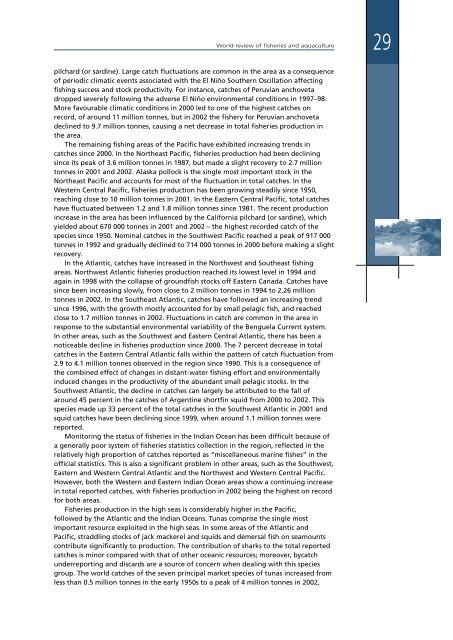State of World Fisheries and Aquaculture 2004 - Library
State of World Fisheries and Aquaculture 2004 - Library
State of World Fisheries and Aquaculture 2004 - Library
You also want an ePaper? Increase the reach of your titles
YUMPU automatically turns print PDFs into web optimized ePapers that Google loves.
<strong>World</strong> review <strong>of</strong> fisheries <strong>and</strong> aquaculture<br />
29<br />
pilchard (or sardine). Large catch fluctuations are common in the area as a consequence<br />
<strong>of</strong> periodic climatic events associated with the El Niño Southern Oscillation affecting<br />
fishing success <strong>and</strong> stock productivity. For instance, catches <strong>of</strong> Peruvian anchoveta<br />
dropped severely following the adverse El Niño environmental conditions in 1997–98.<br />
More favourable climatic conditions in 2000 led to one <strong>of</strong> the highest catches on<br />
record, <strong>of</strong> around 11 million tonnes, but in 2002 the fishery for Peruvian anchoveta<br />
declined to 9.7 million tonnes, causing a net decrease in total fisheries production in<br />
the area.<br />
The remaining fishing areas <strong>of</strong> the Pacific have exhibited increasing trends in<br />
catches since 2000. In the Northeast Pacific, fisheries production had been declining<br />
since its peak <strong>of</strong> 3.6 million tonnes in 1987, but made a slight recovery to 2.7 million<br />
tonnes in 2001 <strong>and</strong> 2002. Alaska pollock is the single most important stock in the<br />
Northeast Pacific <strong>and</strong> accounts for most <strong>of</strong> the fluctuation in total catches. In the<br />
Western Central Pacific, fisheries production has been growing steadily since 1950,<br />
reaching close to 10 million tonnes in 2001. In the Eastern Central Pacific, total catches<br />
have fluctuated between 1.2 <strong>and</strong> 1.8 million tonnes since 1981. The recent production<br />
increase in the area has been influenced by the California pilchard (or sardine), which<br />
yielded about 670 000 tonnes in 2001 <strong>and</strong> 2002 – the highest recorded catch <strong>of</strong> the<br />
species since 1950. Nominal catches in the Southwest Pacific reached a peak <strong>of</strong> 917 000<br />
tonnes in 1992 <strong>and</strong> gradually declined to 714 000 tonnes in 2000 before making a slight<br />
recovery.<br />
In the Atlantic, catches have increased in the Northwest <strong>and</strong> Southeast fishing<br />
areas. Northwest Atlantic fisheries production reached its lowest level in 1994 <strong>and</strong><br />
again in 1998 with the collapse <strong>of</strong> groundfish stocks <strong>of</strong>f Eastern Canada. Catches have<br />
since been increasing slowly, from close to 2 million tonnes in 1994 to 2.26 million<br />
tonnes in 2002. In the Southeast Atlantic, catches have followed an increasing trend<br />
since 1996, with the growth mostly accounted for by small pelagic fish, <strong>and</strong> reached<br />
close to 1.7 million tonnes in 2002. Fluctuations in catch are common in the area in<br />
response to the substantial environmental variability <strong>of</strong> the Benguela Current system.<br />
In other areas, such as the Southwest <strong>and</strong> Eastern Central Atlantic, there has been a<br />
noticeable decline in fisheries production since 2000. The 7 percent decrease in total<br />
catches in the Eastern Central Atlantic falls within the pattern <strong>of</strong> catch fluctuation from<br />
2.9 to 4.1 million tonnes observed in the region since 1990. This is a consequence <strong>of</strong><br />
the combined effect <strong>of</strong> changes in distant-water fishing effort <strong>and</strong> environmentally<br />
induced changes in the productivity <strong>of</strong> the abundant small pelagic stocks. In the<br />
Southwest Atlantic, the decline in catches can largely be attributed to the fall <strong>of</strong><br />
around 45 percent in the catches <strong>of</strong> Argentine shortfin squid from 2000 to 2002. This<br />
species made up 33 percent <strong>of</strong> the total catches in the Southwest Atlantic in 2001 <strong>and</strong><br />
squid catches have been declining since 1999, when around 1.1 million tonnes were<br />
reported.<br />
Monitoring the status <strong>of</strong> fisheries in the Indian Ocean has been difficult because <strong>of</strong><br />
a generally poor system <strong>of</strong> fisheries statistics collection in the region, reflected in the<br />
relatively high proportion <strong>of</strong> catches reported as “miscellaneous marine fishes” in the<br />
<strong>of</strong>ficial statistics. This is also a significant problem in other areas, such as the Southwest,<br />
Eastern <strong>and</strong> Western Central Atlantic <strong>and</strong> the Northwest <strong>and</strong> Western Central Pacific.<br />
However, both the Western <strong>and</strong> Eastern Indian Ocean areas show a continuing increase<br />
in total reported catches, with fisheries production in 2002 being the highest on record<br />
for both areas.<br />
<strong>Fisheries</strong> production in the high seas is considerably higher in the Pacific,<br />
followed by the Atlantic <strong>and</strong> the Indian Oceans. Tunas comprise the single most<br />
important resource exploited in the high seas. In some areas <strong>of</strong> the Atlantic <strong>and</strong><br />
Pacific, straddling stocks <strong>of</strong> jack mackerel <strong>and</strong> squids <strong>and</strong> demersal fish on seamounts<br />
contribute significantly to production. The contribution <strong>of</strong> sharks to the total reported<br />
catches is minor compared with that <strong>of</strong> other oceanic resources; moreover, bycatch<br />
underreporting <strong>and</strong> discards are a source <strong>of</strong> concern when dealing with this species<br />
group. The world catches <strong>of</strong> the seven principal market species <strong>of</strong> tunas increased from<br />
less than 0.5 million tonnes in the early 1950s to a peak <strong>of</strong> 4 million tonnes in 2002,

















